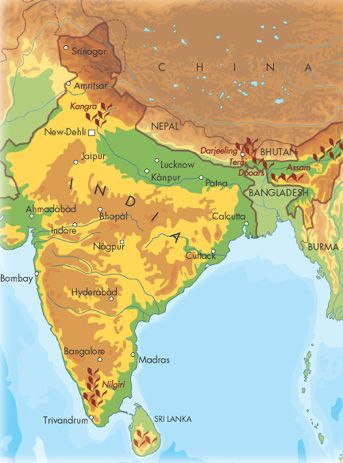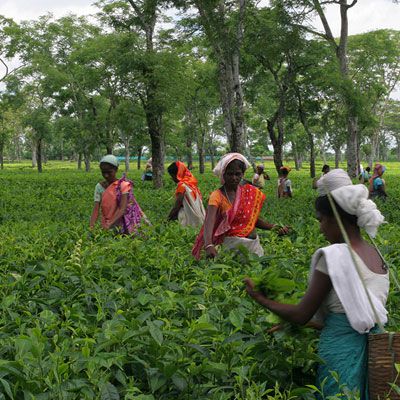There are great differences from one type of Indian tea to another. On the one hand, this is due to the climate and local conditions which can vary greatly from one region to another: from mountainous regions to plateaus or plains; on the other hand because the plantations are not all made up of the same type of tea plant: camelia assamica in Assam, camelia sinensis in the south of India, both varieties in Darjeeling, hybridising etc.

Darjeeling
Darjeelings are high altitude teas, cultivated on plantations situated between 400 and 2,500m above sea level, in the foothills of the Himalayas, on the outskirts of the town Darjeeling, famed for the coolness and purity of its climate. The English started the first plantation in 1856: Tukvar, later to become Puttabong and North Tukvar.
The quality of the teas and the success they enjoyed encouraged the rapid start up of other plantations: Dooteriah in 1859, Ging, Ambootiah, Tukdah, Phoobsering between 1860 and 1864, Badamtam, Makaibari a little later.
The growth of Darjeeling was extremely fast and there are still 90 plantations today. For a long time, 61 of these have been classified into three categories, according to their altitude. If, at one time, these categories may have had some meaning in terms of prestige and fame, today they no longer really make sense, since the quality of the crop on all the plantations has improved, and depends as much on the skill of the planter as it does on the plantation's altitude.
Champagne of teas
Because of its very high price, Darjeeling tea is reserved for export. It is sold in two ways:
- as a "blend": a mixture from different plantations, all designated with the generic name of "Darjeeling".
- in original tea chests for the rarest and finest teas, which are then properly traced: plantation name, grade and batch number.
Darjeeling is one of the most prestigious teas in the world. Its flavour and scent can be very different from one crop to another and from one plantation to another. This depends on:
- the time of plucking (spring, summer, autumn, monsoon season),
- the way in which the tea is plucked,
- the climate conditions,
- the altitude and the direction the plantation faces in relation to the sun,
- the distribution of tea plants on the plantation: whether they come from Assam, China, are cloned, etc.
- the plantation's soil, a bit like local wines.

First flush
The spring flush of Darjeeling, the first of five harvests, usually takes place between the beginning of March and the end of April. It is an event keenly anticipated by the world's tea lovers, since spring Darjeelings, which are produced in very limited quantities, are rare teas, with great aromatic richness, the fineness of which has earned them the sobriquet of the "Champagne of teas".
Throughout the whole winter, the tea plant is allowed to rest and its shoots become full of essential oils. The very first harvests of the year contain a very high percentage of these young shoots, known as "tips" and are often of a very high grade. A spring Darjeeling can be easily recognized by the green hue the leaf takes on when it is infused, although they are black teas. Young and light, its bouquet is fresh and lively.
An essential factor for the first flush is the climatic conditions that precede it; the quality and the flavour of the teas are closely dependent on them and the same plantation can produce very different teas from one year to the next. Every year therefore, Palais des Thés experts go to Darjeeling to taste the product of each plantation so they can make their selection from amongst the best teas and then send them to France. This selection is often available from March onwards for airfreighted teas and from May-June for those shipped by sea.
The fineness and freshness of spring Darjeelings make them very fragile teas that do not age well. To enjoy them at the peak of their quality, it is therefore recommended to drink them "in season", in other words during the nine to twelve months following the harvest.
In-between flush
This is a fairly rare harvest, carried out in early May on some plantations, which combines the freshness of the first flush with the roundness of the summer ones.
Second flush
This harvest is plucked between May and June, during the hot season before the monsoon. The leaf is darker than the spring crops; it has a brown colour and is small. When infused it is shiny and copper-coloured, with a powerful bouquet.
The liqueur, round and golden, is more full-bodied than it is for the first flush. Very aromatic and relatively astringent at the same time, it is long-lasting in the mouth and often has a taste of ripe fruit.
Monsoon flush
Tea produced during the monsoon season, from July to September, is of a lower quality than the other harvests. In fact, it is lacking sun and suffers from too much rain.
Third flush
This harvest gives a tea with large leaves. The liqueur is darker than the second harvest and its aroma more powerful.
Semi-oxidised Darjeeling
Semi-oxidised teas are a speciality of Taiwan and the Fujian region in China. However in Darjeeling, you can find in recent years Oolong teas that are produced locally.
Green Darjeeling
According to the tradition in China and Japan, unoxidised tea is still a rarity in northern India. To accommodate global demand, Darjeeling plants produce more and more green teas.
Assam
The province of Assam is situated in the northeast of India, to the east of Darjeeling between Bangladesh, Myanmar (Burma) and China.
It is a low-lying region, criss-crossed by the Brahmapoutre and its tributaries, that was covered in the early 20th century with tropical rainforest. This fertile region produces more than half of India's tea. The rainfall is the same as in Darjeeling (dry from November to January and wet from April to September) but the rain is much heavier. Two harvests are possible: the first flush however takes place very rarely; the bulk of the output comes between April and October.
Assam teas are vigorous, spicy, tannic and astringent, typically known as "British taste". The infusion is generous and very dark; the liqueur is dark and powerful, and can sometimes be drunk with milk.
These teas are found in all the full-bodied morning blends. If not blended, they must be sold under their label of origin, in other words under the name of the plantation that produced them.
Nilgiri
Nilgiri, which is situated in the south of India, is the second biggest tea-producing region after Assam. This region of plateaux of the same height as those in Sri Lanka, produces teas whose regular leaf and round, full bodied liqueur recall Sri Lankan teas.
Dooars
A region situated to the west of Assam, whose teas are especially aromatic and highly coloured. They are not without a hint of certain summer Darjeeling, which they marry with the roundness and the strength of Assam.
Kangra
The valley of Kangra, situated to the south of Kashmir, produces strong, aromatic teas.
Terai
A tea grown on plantations in Darjeeling, at an altitude of about 300m to 600m above sea level. The infusion has a good colour and the liqueur is strong and consistent in flavour.
